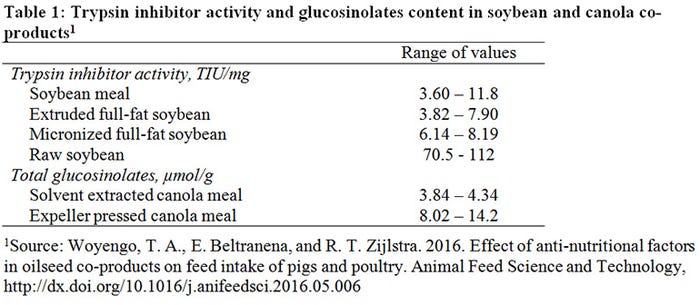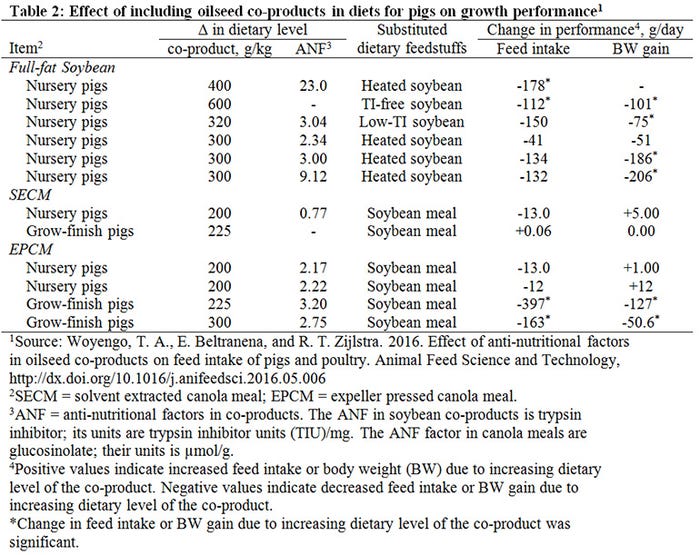The inclusion of soybean co-products in swine diets should partly be based on their TI activity, whereas the inclusion of canola co-products should partly be based on their glucosinolate content.
April 6, 2017

By Tofuko Woyengo, South Dakota State University Department of Animal Science; Eduardo Beltranena, University of Alberta Department of Agricultural, Food and Nutritional Science, Edmonton and Alberta Agriculture and Forestry; and Ruurd Zijlstra, University of Alberta Department of Agricultural, Food and Nutritional Science
Soybean and canola co-products are the most widely used sources of amino acids in swine diets. The most commonly used soybean co-products for formulation of swine diets include soybean meal and full-fat soybean, whereas the most commonly used canola co-product for formulation of swine diets is canola meal. Both soybean and canola co-products contain anti-nutritional factors that can limit their utilization in formulating swine diets. Thus, information on the anti-nutritional factors and the effects of their dietary level on nutrient utilization is critical for optimizing the utilization of these co-products in formulating pig feeds.
The major anti-nutritional factors found in soybean co-products are trypsin inhibitors (TI; that are proteins), whereas the major anti-nutritional factors found in canola co-products are sulphur-containing compounds known as glucosinolates. Nutritive value of soybean and canola co-products for pigs has been determined and reviewed. However, information on the specific effects of the TI in the soybean co-products, and of glucosinolates in the canola co-products on feed intake by pigs have not been reviewed. Therefore, we reviewed results from several studies on the effects of TI and glucosinolates on feed intake by pigs and on mechanisms by which they reduce the feed intake.
The TI bind to enzymes that digest protein in the gut, leading to reduced amino acid digestion and absorption, and to increased secretion of the protein digesting enzymes in an effort to compensate for the reduced protein digestibility. The secretion of these protein-digesting enzymes is mediated by a special type of hormone known as cholecystokinin. One of the other functions of cholecystokinin (in addition to stimulating the secretion of digestive enzymes) is to reduce voluntary feed intake. Thus, TI present in soybean co-products indirectly reduces voluntary feed intake through increased production of cholecystokinin. The TI activity is typically measured in TI units (TIU).
There are two types of TI that are found in soybean co-products — Kunitz TI and Bowman-Birk TI. Of these, Kunitz TI constitutes greater proportion (approximately 70%) of total TI in soybeans. Also, Kunitz TI is more heat-sensitive than Bowman-Birk TI, implying that it can easily be inactivated by subjecting soybean co-products to some form of heat treatment. Thus, raw FFSB has greater TI activity than SBM (Table 1) because soybean seeds are subjected to heat treatment during oil extraction to obtain SBM, whereas raw FFSB is not subjected to heat treatment. Also, extruded, roasted or micronized FFSB has lower TI activity than raw FFSB because the former is subjected to heat treatment. Generally, TI activities in SBM and heat-treated FFSB are less than 6.0 and 7.5 TIU per milligram, respectively. However, raw FFSB has TI activity that is generally greater than 70 TIU per milligram.

Results from several studies indicate that pigs can tolerate TI activity levels up to 3.0 TIU per milligram in the diet (Table 2). This implies that the utilization of SBM with 6.0 TIU per milligram may not be affected by its TI activity when the SBM is included in diets for pigs up to 50%. This also implies that the utilization of FFSB with 7.5 TIU per milligram may not be affected by its TI activity when the SBM is included in diets for pigs up to 40%. However, the inclusion of raw FFSB with TI activity of 90 TIU per milligram should be limited to 3%.

Glucosinolates are bitter and interfere with the functions of the liver, kidneys and thyroid glands. Thus, glucosinolates reduce voluntary feed intake partly because of their bitterness. Glucosinolates may also reduce voluntary feed intake by other unknown mechanisms because dietary glucosinolates reduced feed intake in rats that were harbouring microbes in their gut, but not in germ-free rats. Glucosinolates are typically measured in micromoles (µmol).
Glucosinolate content in canola meal vary depending on oil extraction procedure (Table 1). Solvent-extracted canola meal has lower glucosinolate content than expeller-pressed canola meal because some of the glucosinolates present in solvent-extracted meal are removed when the meal is washed with steam after oil extraction to remove the solvent. However, the concentration of glucosinolates in canola meal is generally less than 10 micromoles per gram. Results from several studies indicate that pigs can tolerate up to about 2.5 micromoles per gram (Table 2). Thus, canola meal with glucosinolate content of 10 micromoles per gram can be included in diets for pigs up to 25% without major effects on feed intake.
In summary, TI activity in soybean co-products and glucosinolates in canola co-products affect feed intake. Thus, the inclusion of soybean co-products in swine diets should partly be based on their TI activity, whereas the inclusion of canola co-products in swine diets should partly be based on their glucosinolate content.
You May Also Like


